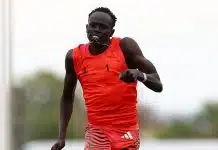One of the members of a chat group your writer frequents re-posts a helpful table each week detailing the latest performances of Australian athletes.
Along with the individual performances, the table lists how the result impacts the athlete’s position on the World Athletics rankings. As you may remember, the world rankings now play a major role in determining which athletes can go to the major championships. An individual’s ranking is one of the two ways in which athletes can qualify. The first is by achieving a tough qualifying standard; the rankings then top up the number of entrants in line with the capped entry number for each event.
The aim of the qualifying system is to select half the field through the automatic qualifying standard and half through the next best rankers. The system was first mooted for the Doha 2019 world championships, but the unease generated by its abrupt (and belated) announcement saw it postponed until the Tokyo Olympics. It has been in use since. For better or worse, one could add, but that’s another matter.

The rankings system was designed to further several outcomes. It would generate narratives of its own, follow the progress of athletes as they strive to qualify for the major championship of the year. Not sure what was expected there, but in terms of mainstream media I’ve not seen, heard or read many stories specifically on the rankings. To be fair, there’s not that many such stories in tennis and golf, two other sports with long established rankings which determine entry into events.
It was likewise designed to encourage athletes to compete more. That works to an extent, but once an athlete has achieved the Big Q, the automatic qualifying standard, they don’t have to worry as much about where and when they compete. And the sort of athletes you want competing more frequently – your Duplantises, McLaughlin-Levrones and other meeting headliners – usually don’t have to worry too much about their ranking as the automatic standard is easily withing their grasp.

To make the system more equitable – athletics is a world sport, after all – there has been a proliferation of permit events. That’s broadly a good thing, but the system has a hierarchy of events which might give more equity but doesn’t make more sense. All area championships carry the same bonus points, all national championships likewise, when they palpably should not.
In terms of the automatic qualifying standards, some events offer greater opportunities than others. It’s relatively common for up to 10 (or more) athletes in a Diamond League middle-distance event to better the automatic standard but is someone running fast in tenth place more worthy of being in a world championship field than someone winning their national title.
What the system has encouraged, it appears, is more competitions where the aim is to get a performance than competitions where everyone’s aim is to win.
Anyway, let’s leave the qualifying system and the world rankings to another day. I’ve got misgivings about both but they fly out the window as soon as the weekly update mentioned way up above lands in the inbox. I don’t know about you, but I’ve rarely met a list into which I could resist the urge to dive. Ten best/worst films, 10 greatest albums, best places to travel, best trains to catch – you name it, I’m there.
And the performance update of which we speak is much more than just a simple list of performances. It also tabulates how these performances have impact on qualifying. Is it a Big Q? Does it produce a net improvement of the athlete’s position vis-à-vis getting to Tokyo25 (it’s possible for an individual improvement to actually leave the athlete worse off if they are swamped by a host of other superior performances around the world in the same period). Where does the level of the last athlete currently inside the field cut-off stand.

Who’s on the rise? Who’s on the wane? On and on it goes until the final date for entries.
And we study the chart in detail. We’ve all become – I don’t know, what’s the word for obsessives who study tables and lists? Chartists? Tabulists?
The rankings update has become the new stock market listings. Or the racing form guide, complete with betting details. You can’t call it a road map; it records the journey without showing the destination.
Whether or not the rankings system is hooking any new fans into athletics is a moot point (probably not, is my best guess). But it’s irresistible bait for the committed fans.















